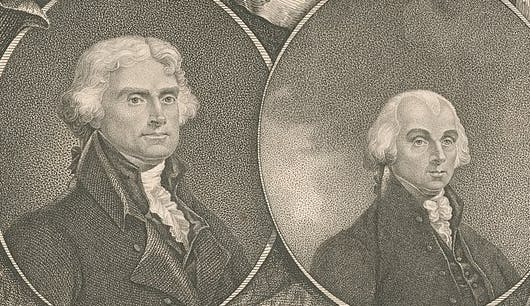Defacing Montpelier and Monticello
To say that Jefferson and Madison were architects of a grand experiment in liberty is hardly to laud them as perfect. Yet today’s transformed Montpelier shocked a visitor as ‘a one hour Critical Race Theory experience disguised as a tour.’

Montpelier and Monticello, the homesteads of James Madison and Thomas Jefferson, are well on their way to becoming museums of the faults of two Founding Fathers. That is according to reporting from the New York Post, which details transformations at these magnificent spaces. Behind these changes is the co-founder of the Carlyle Group, billionaire David Rubenstein. The programming at these sites has undergone a face-lift for the worse.
At Madison’s plantation, few of the displays focus on what the Post calls “the life and accomplishments of America’s foremost political philosopher.” Monticello’s self-described “honest, inclusive narrative about slavery” looked to a visitor quoted by the Post like “trying to rewrite history to make it seem like the Founding Fathers were terrible immoral creatures that happened to start a country.” This is the animus that tears down statues.
To all those who seek the majesty rather than maligning of the authors of the Declaration of Independence and Constitution we commend turning not to the schlock currently on display at Monticello and Montpelier but to the enduring insight of writer and civil rights leader W.E.B. Du Bois. In 1896 the author of “The Souls of Black Folk” composed “The Suppression of the African Slave Trade to the United States of America.”
That work illuminates how at a crucial moment Madison was on the right side of history. Article I, Section 9 of the Constitution prohibited Congress from banning the “importation” of slaves before 1808, or twenty years from the Constitution’s ratification. Madison opposed, in vain, this extension, noting that “So long a term will be more dishonorable to the American character than to say nothing about it in the Constitution.”
Madison reiterated his opposition in 41 Federalist, writing “It ought to be considered as a great point gained in favor of humanity, that a period of twenty years may terminate forever, within these States, a traffic which has so long and so loudly upbraided the barbarism of modern policy; that within that period, it will receive a considerable discouragement from the Federal Government.”
Jefferson was in France when the Constitution was crafted. Madison, who took notes during the Convention, emerges in Du Bois’s pages as an admirable figure, even though he owned slaves and left them to his wife Dolly. Madison hoped that by “expressing a national disapprobation of this trade, we may destroy it, and save ourselves from reproaches, and our posterity the imbecility ever attendant on a country filled with slaves.”
The New York Sun has no interest whatsoever in putting the gloss on the involvement in slavery of either Madison or Jefferson — or any other Founder. To say that Jefferson and Madison were architects of a grand experiment in liberty is hardly to laud them as perfect. Madison himself wrote, in 51 Federalist, that “if men were angels, no government would be necessary.” Unlike George Washington, they did not free their slaves upon their deaths.
Yet so shocking was today’s transformed Montpelier to one visitor that he told the Post that his experience amounted to “a one hour Critical Race Theory experience disguised as a tour.” The bookstore offers for sale “Antiracist Baby,” by professor Ibram X. Kendi. Among other purportedly antiracist measures, he proposes a constitutional amendment to monitor “all local, state and federal public policies to ensure they won’t yield racial inequity.”
We recommend a different text. The historian Myron Magnet’s magisterial “The Founders at Home: The Building of America 1735-1817,” takes as its task the explanation of “why the American Revolution, of all great revolutions, was the only successful one, resulting in two centuries and more of unexampled freedom and prosperity.” Part of his answer was “its strictly limited scope” that “sought only liberty, not equality or fraternity.”
The book was born in Mr. Magnet’s brain when he visited Monticello. It struck him “as a vivid embodiment of Jefferson’s soul, speaking in the most direct and personal way of his ideals and worldview.” He compared it to “being at the excavation of Pompeii, breathlessly watching a long-lost past come back to light.” When you visit the houses of the Founders, he writes, “you will know that you are in their presence.” That is what we stand to lose by what is being done at these homes.
In 1807, Congress passed a statute ending the importation of slaves at the first possible moment, which was as the clock tolled in January 1, 1808. The president who signed that act turned out to be Thomas Jefferson, of Monticello. Madison and Jefferson had been promoting this legislation for 40 years. The transformation of the homes of these men is a historical distortion, prelude to greater alterations to the narrative of the country they built as the homeland of liberty.

